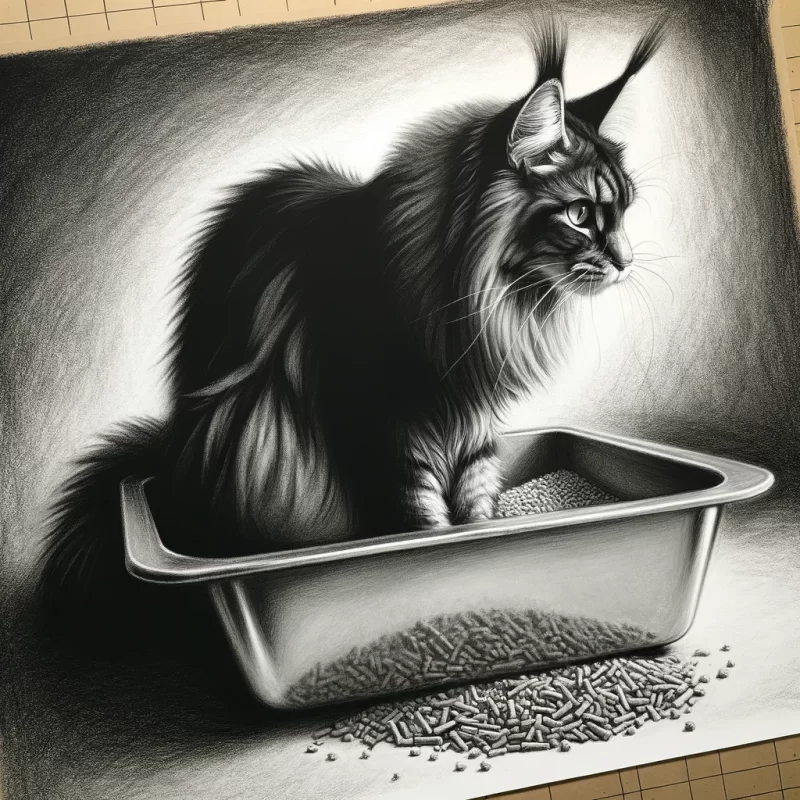Blog
How to Choose the Best Litter for Odour Control

Choosing the best litter for odour control is crucial for sustainable cat owners. This guide will help you make an informed decision.
As a responsible cat owner, you want to ensure that your furry friend’s litter box remains odour-free while being mindful of the environment. Each cat is unique, and so is each household, so instead of forcing a true-for-all-impossible answer, we prefer to be honest about it and provide you with the tools to make the choice that best suits you, your cats and your household necessities.
1. Consider Natural and Biodegradable Options
When choosing the best litter for odour control in a sustainable manner, considering natural and biodegradable options is a crucial step. Not only do these types of litter help keep your cat’s litter box fresh and odour-free, but they also contribute to a healthier environment. Let’s explore why choosing natural and biodegradable litter is smart.
Benefits of Natural Materials
Natural litters are made from renewable resources such as corn, wheat, pine, coffee grounds, tofu or recycled paper. These materials are not only eco-friendly but also offer excellent odour-control properties. They are often free from harmful chemicals and synthetic fragrances, making them safer for your cat and the environment.
Biodegradability and Reduced Waste
One of the critical advantages of natural and biodegradable litter is their ability to break down quickly. Unlike traditional clay litter, which can take centuries to decompose, natural litters are designed to biodegrade quickly. This means they won’t contribute to the ever-growing landfill problem when you dispose of them.
By choosing biodegradable options, you actively reduce waste and minimise your carbon footprint. This sustainable approach helps protect natural resources and supports a healthier ecosystem.
Environmental Impact
When selecting a natural or biodegradable litter, it’s essential to consider the brand’s commitment to sustainability. Look for certifications such as the Forest Stewardship Council (FSC) or the Rainforest Alliance, which ensure responsible sourcing practices. These certifications guarantee that the materials used in the litter are harvested in an environmentally friendly and socially responsible manner.
Additionally, some brands go the extra mile by using recycled materials in their packaging, reducing their environmental impact. By supporting these brands, you encourage sustainable practices throughout the product lifecycle.
Performance and Odor Control
Natural and biodegradable litter are environmentally friendly and highly effective in controlling odours. Many of these litters utilise natural ingredients like activated carbon or baking soda, which have excellent odour-absorbing properties. They work to neutralise unpleasant smells, keeping your home fresh and clean.
Furthermore, these litters often clump well, making scooping and maintaining a hygienic litter box easier. The clumping ability allows for efficient waste removal, ensuring that odorous waste is promptly eliminated. Some litters have low tracking properties, furthering odour control since possible soiled litter particles stay closer to the litter box and ensure an easier area clean-up.
Allergen Reduction
Another advantage of natural litters is their potential to reduce allergens. Traditional clay litter can contain dust and other particles that may trigger allergies in cats and humans. On the other hand, natural litters tend to have lower dust levels, minimising the risk of respiratory issues.
Choosing natural and biodegradable litters creates a healthier and more comfortable environment for you and your feline companion.
In conclusion, it is wise to consider natural and biodegradable options when choosing the best litter for odour control. These litters offer numerous benefits, including reduced waste, environmental sustainability, excellent odour control, and potential allergen reduction. By making this choice, you are providing a clean and fresh litter box for your cat and contributing to a greener and more sustainable future.
2. Look for Low Dust Formulas
When searching for the best litter for odour control in a sustainable manner, it’s important to consider litters with low dust formulas. Dust can be a nuisance for you and your cat, causing respiratory issues and creating a mess around the litter box. Let’s explore why choosing low-dust formulas benefits you and your feline companion.
Respiratory Health
Cats are known for their sensitivity to dust particles, and prolonged exposure to dusty environments can lead to respiratory problems. Traditional clay litters often generate a significant amount of dust when poured or disturbed, increasing the risk of respiratory issues for you and your cat.
By choosing a litter with a low dust formula, you can minimise the amount of airborne particles in your home. This helps create a healthier environment for everyone, reducing the chances of respiratory discomfort or allergies.
Cleanliness and Hygiene
Low-dust formulas benefit your cat’s health and contribute to a cleaner and more hygienic litter box area. Dust particles can settle on surfaces surrounding the litter box, creating a layer of fine particles that can be difficult to clean.
Selecting a litter with minimal dust can reduce the dust that settles outside the litter box. This makes cleaning and maintaining the litter box area much easier, ensuring a tidy and pleasant space for you and your cat.
Testing and Reviews
When researching low-dust litters, it’s helpful to read reviews and consider the experiences of other cat owners. Look for feedback about the litter’s dust levels and how it affected their cats’ respiratory health. Real-life experiences can provide valuable insights into the effectiveness of a litter’s low-dust formula.
Performance and Odor Control
While focusing on low dust formulas, ensuring the litter performs well in odour control is essential. Look for litters that have minimal dust and effectively neutralise odours. A combination of low dust and strong odour control will provide the best experience for you and your cat. We encourage you to look for fragrance-free litter sorties since some cats can be picky.
Testing Different Litters
Every cat is unique, and what works for one may not work for another. Consider testing different low-dust litters to find the one that suits your cat’s preferences and needs. Some cats may have specific sensitivities or preferences regarding litter texture and scent. You can find the perfect balance between low dust and your cat’s comfort by testing different options.
In conclusion, choosing a litter with a low dust formula is essential for maintaining a healthy and clean environment for you and your cat. Minimising dust particles can reduce the risk of respiratory issues and create a more hygienic litter box area. Consider reviews, test different litters, and ensure the low dust formula doesn’t compromise the litter’s odour control capabilities. With careful consideration, you can find a low-dust litter that provides optimal performance while prioritising your cat’s well-being.
3. Evaluate Odor Control Features
When selecting the best litter for sustainability, it’s crucial to evaluate the odour control features of different litters. Effective odour control is essential for maintaining a fresh and pleasant environment for you and your cat. Let’s explore why evaluating odour control features is essential and what to look for when choosing a litter.
Understanding Odor Sources
To effectively control odours, it’s essential to understand their sources. In the case of cat litter, the primary odour culprits are cat urine and the resulting ammonia. When urine comes into contact with the litter, it can release ammonia, which produces a strong and unpleasant smell.
Clumping Ability
Litters with good clumping ability are often effective in controlling odours. When urine comes into contact with these litters, they form tight clumps that can be easily scooped out. This helps remove the odour source quickly and efficiently, keeping the litter box fresh.
Look for litters that specifically mention their clumping ability in their product descriptions. Brands that prioritise clumping often have superior odour control capabilities.
Odor Absorbing Ingredients
Many litters incorporate odour-absorbing ingredients to neutralise unpleasant smells. Common examples include charcoal, activated carbon and baking soda. These ingredients work by trapping and neutralising odorous molecules, preventing them from spreading throughout your home.
When evaluating litter, look for those that include odor-absorbing ingredients. These additives can significantly enhance the litter’s ability to control odours.
Long-lasting Odor Control
Consider litters that offer long-lasting odour control. Some litters are designed to provide extended odour control, ensuring that your cat’s litter box remains fresh for an extended period. This can be particularly beneficial if you have multiple cats or limited daily litter box maintenance time.
User Reviews and Recommendations
Reading user reviews and seeking recommendations from other cat owners can provide valuable insights into a litter’s odour control capabilities. Look for feedback specifically mentioning the litter’s effectiveness in controlling odours. Real-life experiences can help you decide and choose a litter that meets your odour control needs.
Testing Different Litters
Every cat is unique, and what works for one may not work for another. Consider testing different litters to find the one that effectively controls odours for your cat. Some litters may work better with certain types of urine or in specific litter box setups. You can find the litter that best suits your cat’s needs and provides optimal odour control by testing different options.
In conclusion, evaluating the odour control features of different litters is crucial for choosing the best litter for odour control in a sustainable manner. Consider the clumping ability, presence of odour-absorbing ingredients, long-lasting odour control, user reviews, and recommendations. By carefully evaluating these factors and testing different litters, you can find the one that effectively controls odours, ensuring a fresh and pleasant environment for you and your cat.
4. Consider Clumping Ability
When searching for the best litter for sustainable odour control, it’s important to consider the clumping ability of different litters. Clumping litter makes it easier to maintain a clean and odour-free litter box. Let’s explore why considering clumping ability is crucial and what to look for when choosing a litter.
Easy Waste Removal
Litters with good clumping ability form tight and solid clumps when they come into contact with urine. These clumps make scooping and removing the waste from the litter box easier. By quickly and efficiently removing the waste, you can minimise odours and maintain a clean litter box environment.
Odor Control
Clumping litter simplifies waste removal and contributes to effective odour control. When the litter forms tight clumps around the urine, it helps encapsulate the odour source, preventing it from spreading throughout your home. This ensures a fresher and more pleasant environment for you and your cat.
Reduced Litter Waste
Litters with good clumping ability often result in less litter waste. As only the soiled clumps need to be removed, you can extend the lifespan of the litter in the box. This reduces the frequency of litter changes and helps minimise the litter in the landfill.
Scooping Convenience
The ability to easily scoop out clumps from the litter box adds convenience to your daily routine. It saves time and effort, making litter box maintenance more manageable. This is particularly beneficial for busy cat owners or those with multiple cats. Also, a litter box with a sturdy, clean, easy-to-maintain surface comes in handy: we highly recommend stainless steel litter boxes as the ultimate clean, sustainable solution for litter boxes.
Clump Strength and Durability
When evaluating litter, consider the strength and durability of the clumps they form. Look for litters that create solid clumps that won’t break apart during scooping. This ensures that the waste is entirely removed without leaving any residue behind.
Testing Different Litters
Every cat is unique, and their preferences regarding litter texture and clumping ability may vary. Consider testing different litters to find the one that suits your cat’s needs and your desired level of clumping ability. Some cats prefer finer or coarser textures, while others have specific sensitivities. By testing different options, you can find the litter that provides optimal clumping ability for your cat’s comfort.
In conclusion, considering the clumping ability of different litters is essential for maintaining a clean and odour-free litter box. Look for litters that form tight and solid clumps, making waste removal easy and efficient. Additionally, consider the durability of the clumps and the convenience they offer during scooping. By testing different litters, you can find the one that best suits your cat’s preferences and provides excellent clumping ability, ensuring a fresh and hygienic litter box environment.
5. Assess Environmental Impact

Research the environmental impact of the litter brand you are considering. Look for certifications such as the Forest Stewardship Council (FSC) or the Rainforest Alliance, which ensure sustainable sourcing practices.
When choosing the best litter for odour control in a sustainable manner, it’s important to assess the environmental impact of different litters. Opting for a litter brand that prioritises sustainability helps minimise your carbon footprint and supports a healthier planet. Let’s see why assessing the environmental impact is crucial and what factors to consider when evaluating litter.
Sustainable Sourcing
Look for litter brands that prioritise sustainable sourcing practices. Consider whether the materials used in the litter are renewable, responsibly harvested, or made from recycled materials. Brands prioritising sustainable sourcing help protect natural resources and reduce environmental impact.
Certifications and Standards
Check for certifications and standards that indicate a brand’s commitment to sustainability. Look for certifications such as the Forest Stewardship Council (FSC) or the Rainforest Alliance. These certifications ensure the litter’s materials are sourced from responsibly managed forests or other sustainable sources.
Biodegradability and Compostability
Consider litters that are biodegradable or compostable. These litters break down naturally over time, reducing waste and minimising their environmental impact. Biodegradable litters often utilise materials such as corn, wheat, pine, or recycled paper, which are renewable and eco-friendly.
Packaging and Waste Reduction
Evaluate the packaging of the litter brand you are considering. Look for brands that use minimal packaging or opt for eco-friendly packaging materials. Some brands even use recycled or recyclable materials for their packaging, further reducing their environmental impact. Go for the ones using paper bags, cardboard boxes, aluminium foil or biodegradable corn starch bags, and push the other brands to follow down this line.
Carbon Footprint
Consider the carbon footprint of the litter brand. Some brands actively work to reduce their carbon emissions through various initiatives, such as using renewable energy sources or offsetting their carbon emissions. Choosing a brand with a lower carbon footprint contributes to a more sustainable choice.
User Reviews and Transparency
Read user reviews and seek information about a brand’s environmental practices. Look for feedback from other cat owners who have assessed the ecological impact of the litter. Brands that are transparent about their sustainability efforts and provide clear information about their environmental impact are more likely to align with your values.
Supporting Sustainable Initiatives
By choosing a litter brand with a positive environmental impact, you support sustainable initiatives and encourage responsible practices within the industry. Your decision can contribute to a greener future and inspire others to make eco-conscious choices.
In conclusion, assessing the environmental impact of different litters is crucial for choosing the best litter for odour control in a sustainable manner. Consider sustainable sourcing, certifications, biodegradability, packaging, carbon footprint, user reviews, and transparency. Choosing a litter brand that prioritises sustainability can minimise your environmental footprint and contribute to a healthier planet for future generations.
6. Read Reviews and Seek Recommendations
Read reviews from other cat owners who have used the litter you are interested in. Their experiences can provide valuable insights into the litter’s odour control capabilities and sustainability.
When searching for the best litter for odour control in a sustainable manner, reading reviews and seeking recommendations can provide valuable insights. However, it’s essential to acknowledge that no online blog or influencer can test all litters without potentially causing stress to their cats. Constantly changing litters can be a significant source of feline stress. Let’s explore why reading reviews and seeking recommendations is still beneficial and how to approach it responsibly.
Gathering Insights from Other Cat Owners
Reading reviews and seeking recommendations from other cat owners can provide valuable insights into the performance and effectiveness of different litters. Real-life experiences can help you understand how well a litter controls odours, clumping ability, and other important factors.
Consider Multiple Sources
When reading reviews, it’s essential to consider multiple sources to get a well-rounded perspective. Look for reviews on reputable websites, forums, or social media platforms dedicated to cat owners. This can help you gather a range of opinions and experiences.
Look for Specific Feedback
Pay attention to reviews that specifically mention odour control, sustainability, and other essential factors. Look for feedback from cat owners who have similar priorities and values. Their experiences can provide valuable insights into whether a particular litter aligns with your needs.
Understand Limitations
Keep in mind that no single litter will work perfectly for every cat. Each cat has unique preferences and sensitivities. What works well for one cat may not work for another. Consider the overall consensus from reviews and recommendations, but also be open to testing different litters to find the best fit for your cat.
Responsible Approach to Testing
It’s essential to approach testing different litters responsibly, considering the potential stress it may cause to your cat. Constantly changing litter can disrupt your cat’s routine and lead to litter box aversion or stress-related behaviours. Instead, consider introducing new litters gradually and observing your cat’s response. If your cat shows signs of stress or discomfort, it may be best to stick with a litter that they are already accustomed to.
Consulting with Your Veterinarian
If you need help deciding which litter to choose or have concerns about your cat’s needs, consult your veterinarian. They can provide personalised recommendations based on your cat’s health, preferences, and specific considerations.
In conclusion, reading reviews and seeking recommendations can provide valuable insights when choosing the best litter for odour control. However, it’s essential to approach it responsibly, considering the limitations and potential stress it may cause to your cat. Look for multiple sources, consider specific feedback, and be mindful of your cat’s well-being. By gathering information from various sources and consulting with your veterinarian, you can make an informed decision that prioritises odour control and your cat’s comfort.
7. Test Different Brands
Every cat is unique, and what works for one may not work for another. Consider trying out different brands and types of litter to find the best fit for your cat’s needs and sustainability goals.
Let’s see why testing different brands is beneficial and how to approach it effectively.
Catering to Your Cat’s Preferences
Cats have individual preferences regarding litter texture, scent, and clumping ability. By testing different brands, you can determine which litter best suits your cat’s preferences. Some cats may prefer finer or coarser textures, unscented or lightly scented options, or specific clumping abilities. Testing different brands allows you to find the one that your cat finds most comfortable and appealing.
Assessing Odor Control Performance
While reviews and recommendations can provide insights into a litter’s odour control capabilities, testing different brands allows you to assess their performance firsthand. You can observe how well each litter controls odours in your specific environment and with your cat’s waste. This hands-on experience helps you make a more informed decision based on real-life results.
Considering Sustainability Factors
Testing different brands allows you to assess their sustainability factors beyond odour control. You can evaluate their environmental impact, such as the materials used, packaging, and any certifications or eco-friendly initiatives. By trying out different brands, you can choose a litter that controls odours effectively and aligns with your sustainability values.
Introducing Litters Gradually
When testing different brands, it’s essential to introduce new litters gradually to minimise stress for your cat. Abrupt changes in the litter can lead to litter box aversion or stress-related behaviours. Start by mixing a small amount of the new litter with the existing silica or clay litter, gradually increasing the ratio over time. Observe your cat’s response and ensure they are comfortable with the new litter before fully transitioning. Do the same when transitioning from one sustainable litter to another.
Monitoring Your Cat’s Reaction
While testing different brands, closely monitor your cat’s reaction to each litter. Watch for any signs of discomfort, litter box aversion, or changes in behaviour. If your cat shows signs of stress or discomfort with a particular litter, it may be best to discontinue its use and try another brand. Your cat’s well-being and comfort should always be a priority.
Consulting with Your Veterinarian
Consult with your veterinarian if you have concerns or questions during the testing process. They can provide guidance and recommendations based on your cat’s needs and health considerations. Your veterinarian’s expertise can help you navigate the testing process and ensure the best outcome for your cat.
In conclusion, testing different brands is an effective way to sustainably find the best litter for odour control. You can make an informed decision by catering to your cat’s preferences, assessing odour control performance, and considering sustainability factors. Remember to introduce new litters gradually, monitor your cat’s reaction, and consult with your veterinarian if needed. With patience and observation, you can find the ideal litter that meets your cat’s needs and sustainability goals.
8. Proper Disposal
Dispose of used litter responsibly. If you choose a biodegradable option, it can often be composted. If not, ensure it is disposed of in a way that minimises its environmental impact.
By following these steps, you can sustainably choose the best litter for odour control. Remember, a clean and odour-free litter box benefits your cat’s health and contributes to a cleaner environment.
Responsible disposal practices help minimise the environmental impact and maintain a clean and hygienic living space. Let’s explore why proper disposal is crucial and how to dispose of used litter in an eco-friendly manner.
Bagging and Sealing
When scooping out used litter, it’s important to bag and seal it properly before disposal. Use biodegradable or compostable bags, as they are more environmentally friendly. Double-bagging can provide an extra layer of protection against odours and leakage.
Separate Waste from Clumps
Separate the waste from the clumps before disposal. This ensures that only the waste is discarded, while the clumps can be composted if the litter is biodegradable. By separating the waste, you can minimise the amount of litter in landfills.
Composting Biodegradable Litter
If you use biodegradable litter, check if it is suitable for composting. Some biodegradable litter can be composted in a home composting system. Follow the manufacturer’s instructions for composting, and ensure that the compost is used for non-edible plants only.
Disposing in Trash Bins
If composting is not an option, dispose of the bagged litter in the regular trash bin. Ensure that the bag is securely tied to prevent any leakage or odours. Be mindful of local regulations regarding waste disposal and follow the guidelines provided by your municipality.
Avoid Flushing
Avoid flushing cat litter down the toilet. Cat litter, even if labelled as flushable, can cause plumbing issues and harm aquatic ecosystems. Flushing litter can introduce harmful bacteria and parasites into the water supply. It’s best to stick to proper disposal methods rather than flushing.
Cleaning the Litter Box
Regularly clean the litter box to maintain hygiene and minimise odours. Empty the litter box, wash it with mild soap and water, and dry it thoroughly before refilling it with fresh litter. This helps prevent bacteria buildup and keeps the litter box fresh for your cat. We strongly recommend using stainless steel litter boxes!
Responsible Disposal Education
Educate yourself and others about responsible litter disposal practices. Share information with fellow cat owners, friends, and family to promote eco-friendly habits. By spreading awareness, you can contribute to a collective effort to minimise the environmental impact of cat litter disposal.
In conclusion, proper disposal of used litter is essential for maintaining a sustainable and clean environment. Bag and seal the litter before disposal, separate waste from clumps, and consider composting biodegradable litter if possible. Follow local waste disposal guidelines and avoid flushing litter down the toilet. Regularly clean the litter box to maintain hygiene. By practising responsible disposal and educating others, you can positively impact the environment and ensure a healthier future.
Conclusions and Frequently Asked Questions
In this guide, we have explored how to choose the best litter for odour control sustainably. We discussed the importance of considering natural and biodegradable options, looking for low-dust formulas, evaluating odour control features, assessing environmental impact, testing different brands, and proper disposal. By following these guidelines, you can make an informed decision that aligns with your sustainable cat owner values.
Choosing the suitable litter for odour control is crucial for maintaining a clean and fresh litter box environment. Opting for natural and biodegradable options can minimise your environmental impact while effectively controlling odours. Low dust formulas help protect both you and your cat’s respiratory health. Evaluating odour control features, such as clumping ability and odour-absorbing ingredients, ensures optimal performance. Assessing the environmental impact of litter and proper disposal practices contribute to a greener future. Testing different brands allows you to find the litter that best suits your cat’s preferences and needs.
Can I test different litters without causing stress to my cat?
Testing different litters can be valuable in finding the best litter for odour control, but it’s essential to approach it in a way that minimises stress for your cat. Cats are creatures of habit and can be sensitive to environmental changes, including introducing new litter. Here are some tips to help you test different litters without causing stress to your cat:
Gradual Transition
Introduce new litters gradually to allow your cat to adjust comfortably. Start by mixing a small amount of the new litter with the existing litter in the litter box. Over time, gradually increase the new litter’s ratio while decreasing the old litter’s amount. This gradual transition helps your cat familiarise with the new litter without sudden changes that may cause stress.
Observe Behavior
Pay close attention to your cat’s behaviour during the transition period. Monitor their litter box usage, body language, and overall demeanour. Look for signs of stress, such as avoiding the litter box, excessive scratching, or changes in appetite. If you notice any discomfort or stress, consider slowing the transition process or reverting to the previous litter.
Provide Familiarity and Comfort
Ensure that your cat has a comfortable and familiar environment during the transition. Keep their litter box in a quiet and accessible location, away from high-traffic areas or loud noises. Maintain their regular feeding and playtime routines to provide stability and security. Creating a calm, stress-free environment can help your cat adjust quickly to the new litter.
Use Positive Reinforcement
Encourage your cat to use the new litter by providing positive reinforcement. Offer treats, praise, or playtime near the litter box when they use the new litter successfully. This positive association can help your cat feel more comfortable and confident with the new litter.
Respect Your Cat’s Preferences
Remember that each cat is unique and may have specific preferences regarding litter. Some cats may prefer a certain texture, scent, or clumping ability. If your cat consistently dislikes a particular litter, respect their choices and try different options that align with their comfort.
Consult with Your Veterinarian
Consult your veterinarian if you have concerns about testing different litters or your cat’s response to the transition. They can provide guidance based on your cat’s specific needs and help you navigate the process in a way that minimises stress.
In conclusion, testing different litters can be done without causing undue stress to your cat by following a gradual transition, observing behaviour, providing familiarity and comfort, using positive reinforcement, respecting preferences, and seeking guidance from your veterinarian. By approaching the process with patience and sensitivity, you can find the best litter for odour control while prioritising your cat’s well-being.
How often should I clean the litter box?
Maintaining a clean litter box is essential for your cat’s health and well-being. The frequency of cleaning depends on various factors, including the number of cats, litter type, and your cat’s preferences. Here are some guidelines to help you determine how often to clean the litter box:
Regular Scooping
Scooping the litter box daily is recommended to remove solid waste and clumps. This helps prevent odours and keeps the litter box clean and inviting for your cat. Regular scooping allows you to monitor your cat’s litter box habits and identify potential health issues.
Full Litter Box Cleaning
In addition to daily scooping, cleaning the full litter box is essential. This involves emptying the litter box, washing it with mild soap and water, and drying it thoroughly before refilling it with fresh litter. The frequency of complete cleaning depends on factors such as the number of cats and the type of litter used. Please make sure to use stainless steel litter boxes!
Multi-Cat Household
You may need to clean the litter box more frequently if you have multiple cats. Cats tend to have individual preferences and may prefer separate litter boxes. Providing multiple litter boxes can help prevent overcrowding and ensure that each cat has access to a clean litter box.
Litter Type and Odor Control
The type of litter you use can also influence the cleaning frequency. Some litters have better odour control capabilities and may require less frequent cleaning. However, even with highly effective litter, regular scooping and complete cleaning are necessary to maintain cleanliness and prevent odour buildup.
Cat Preferences and Behavior
Observe your cat’s behaviour and litter box habits. Some cats may be more particular about cleanliness and require more frequent cleaning. If you notice your cat avoiding the litter box or showing signs of discomfort, it may indicate that it needs more frequent cleaning.
Personalize Cleaning Schedule
Ultimately, it’s essential to personalise the cleaning schedule based on your cat’s needs and your preferences. Regularly monitor the litter box, adjust the cleaning frequency as needed, and be attentive to any changes in your cat’s behaviour or litter box habits.
In conclusion, maintaining a clean litter box is crucial for your cat’s hygiene and well-being. Daily scooping and regular complete cleaning are recommended. Consider the number of cats, litter type, and your cat’s preferences when determining the appropriate cleaning frequency. Keeping the litter box clean provides a comfortable and inviting space for your cat to do their business.
What if my cat has specific sensitivities or preferences?
Every cat is unique; some may have specific sensitivities or preferences regarding their litter box. It’s essential to consider and accommodate these needs to ensure your cat’s comfort and well-being. Here are some tips for addressing your cat’s sensitivities or preferences:
Litter Texture
Some cats may have preferences for a specific litter texture. Experiment with different textures, such as fine-grain, medium-grain, or coarse-grain litters, to see which one your cat prefers. Observe their behaviour and litter box usage to determine the texture that they find most comfortable.
Scented Litter vs. Unscented Litter
While scented litters may appeal to humans, some cats may be sensitive to strong fragrances. Consider switching to unscented options if your cat shows aversion or discomfort with scented litters. Unscented litter can provide a more neutral and comfortable environment for your cat.
Clumping Ability
Clumping ability is another factor that can affect your cat’s litter box experience. Some cats prefer litters with strong clumping ability, while others may find it uncomfortable. Test different litters with varying clumping abilities to see which one your cat prefers. Pay attention to your cat’s behaviour and whether it shows any signs of discomfort.
Allergies or Sensitivities
If your cat has known allergies or sensitivities, choosing a litter compatible with their needs is essential. Consider hypoallergenic or natural litters that are free from potential irritants or allergens. Consult with your veterinarian if you suspect your cat has specific sensitivities that must be addressed.
Multiple Litter Boxes
If you have multiple cats, each with its own sensitivities or preferences, consider providing multiple litter boxes with different litter options. This will allow each cat to choose the litter that suits them best and help prevent litter box aversion or competition.
Gradual Transition
Introduce a new litter gradually to address your cat’s sensitivities or preferences. Mix a small amount of the new litter with the existing litter, increasing the ratio progressively over time. This gradual transition helps your cat adjust more comfortably to the new litter.
Consult with Your Veterinarian
If you have concerns about your cat’s specific sensitivities or preferences, consult with your veterinarian. They can provide personalised recommendations based on your cat’s health and needs.
In conclusion, catering to your cat’s sensitivities and preferences is essential for their overall litter box experience. Consider their preferences for litter texture, scent, and clumping ability. Address any known allergies or sensitivities with appropriate litter choices. Provide multiple litter boxes if you have multiple cats with different preferences. Gradually transition to new litters to ensure your cat’s comfort. Consulting with your veterinarian can provide valuable guidance in addressing your cat’s needs.
How can I reduce litter waste?
Reducing litter waste is beneficial for the environment and helps promote sustainability in cat ownership. Here are some tips to help you minimise litter waste:
Choose Litters with Good Clumping Ability
Opt for litters with good clumping ability, allowing for efficient waste removal. These litters form solid clumps around urine, making it easier to scoop out and discard only the waste rather than replacing the entire litter box.
Consider Biodegradable or Compostable Litter
Choose biodegradable or compostable litters that break down naturally over time. These litters are typically made from renewable and eco-friendly materials such as corn, wheat, pine, or recycled paper. They reduce the overall waste generated and have a lower environmental impact.
Use Litter Box Liners
Consider using litter box liners made from biodegradable or compostable materials. These liners make removing and disposing of used litter easier, reducing the amount of litter in landfills. Ensure that the liners are compatible with your chosen litter type.
Use a stainless steel litter box.
These boxes are durable and long-lasting, and can be used repeatedly, reducing the need to dispose of liners altogether. Additionally, they are easy to clean and sanitize, ensuring that they remain hygienic for your furry friend. While they may be a bit more expensive upfront, the investment pays off in the long run as they are more cost-effective and environmentally friendly.
Scoop Regularly
Scooping the litter box regularly helps maintain cleanliness and reduces the amount of litter that needs to be replaced. By removing solid waste and clumps daily, you can extend the lifespan of the litter and minimise waste.
Use Less Litter
Avoid overfilling the litter box with excessive amounts of litter. Follow the manufacturer’s guidelines for recommended litter depth. Using appropriate litter ensures effective odour control and reduces unnecessary waste.
Reuse and Recycle Packaging
Consider reusing or recycling the packaging of your cat litter. Some litter brands use recyclable materials, allowing you to dispose of it responsibly. Alternatively, you can repurpose the packaging for other household needs to reduce waste.
Donate Unused Litter
If you have unused litter that your cat no longer prefers or if you have switched to a different brand, consider donating it to local animal shelters or rescue organisations. This helps reduce waste and supports organisations in need.
Educate Others
Spread awareness among fellow cat owners, friends, and family about reducing litter waste. Share tips and information on eco-friendly litter choices and proper waste management. Educating others can contribute to a collective effort to minimise litter waste.
In conclusion, reducing litter waste is achievable through conscious choices and responsible practices. Choose litters with good clumping ability, opt for biodegradable or compostable options, and use litter box liners made from eco-friendly materials. Regular scooping, using less litter, and reusing or recycling packaging reduces waste. Donating unused litter and educating others about sustainable practices further promote a greener approach to cat ownership. By implementing these strategies, you can minimise litter waste and positively impact the environment.
Feel free to reach out if you have any further questions or need additional assistance. We’re here to help you make the best choices for your cat and the environment.









